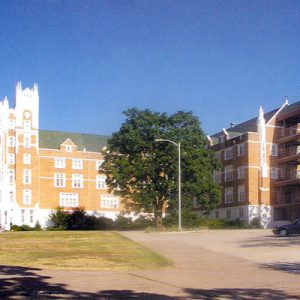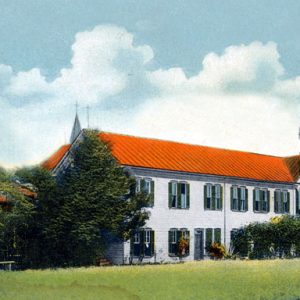calsfoundation@cals.org
St. Scholastica Monastery
St. Scholastica Monastery, a community of Catholic Benedictine sisters in Fort Smith (Sebastian County), has been a religious presence in the state of Arkansas since its founding in 1879. Their call is not to any specific work but rather to a life of seeking God through common and private prayer, work, leisure, and extending hospitality in service to the needs of the church and civic community. By living that call, they have impacted the lives of many in the state and beyond in education, healthcare, and social service. The sisters’ contribution includes having staffed three girls’ high schools for boarding and day students; conducting elementary schools; operating four hospitals in rural areas; and caring for children in an orphanage in Pine Bluff (Jefferson County) from 1932 to 1938 and an orphanage, school, and daycare facility in North Little Rock (Pulaski County) from 1907 to 1997.
The monastery traces its beginnings to the late 1800s, when the Little Rock and Fort Smith Railroad, a branch of the Cairo and Fulton Railroad, received land grants from the U.S. government to attract settlers to the lands along the railroad in Arkansas. To attract German immigrants, the railroad company enticed the Benedictine sisters of the Monastery of the Immaculate Conception in Ferdinand, Indiana, to send sisters to Arkansas, offering 100 acres of land and $2,500 for the sisters to build a church and school in rural Logan County. Four sisters arrived from Ferdinand in the fall of 1878. Since their log cabin was not yet constructed, they remained at Subiaco, then known as Creole, where two of them taught in an elementary school while the other two did housework for the Benedictine monks who had arrived the previous spring to establish their own monastery. When the sisters’ log cabin was completed on January 23, 1879, the two who were not teaching moved to Shoal Creek, about ten miles east of Subiaco and sixty miles east of Fort Smith, where they also opened an elementary school. The founding members of St. Scholastica were: Sisters Xaveria Schroeder (age thirty-four), Isidora Lubberman (age twenty-three), Josepha Schmidt (age twenty-one), and Bonaventura Wagner (age twenty-one).
The first prioress, Mother Meinrada Lex, who served from 1887 to 1908, worked to establish the community’s financial viability. In 1908, Mother Agatha Ehalt, one of the first women to enter the community at Shoal Creek in 1882, was elected the second prioress and served for twelve years, during which she built an infirmary for those members who had contracted flu, typhoid, and tuberculosis.
As far as they were able, St. Scholastica responded to the mandate of the 1884 Council of Baltimore to staff schools where there was a Catholic church, regardless of the ethnic background of the people there. Requests for teaching sisters were many, and the number of available sisters was too few to meet the demand. Besides recruiting some young women from the United States, the sisters made trips to Europe to seek volunteers to join St. Scholastica. As a result of these trips, about a third of the early membership came from Germany and Switzerland, but as the years went by, almost all the new membership came from the United States.
The sisters’ concern also included the children in rural Arkansas parishes where there were no Catholic schools. The teachers and students of St. Scholastica Academy conducted correspondence courses in religion for these children. During the summer months, sisters who taught in regular classrooms during the year conducted Vacation Bible Schools for any children wishing to attend.
In 1916, a small Benedictine community in Pilot Grove, Missouri, became affiliated with St. Scholastica in Shoal Creek. Since the Pilot Grove sisters owned and operated a hospital and nursing school in Boonville, Missouri, the sisters at St. Scholastica also adopted the work of healthcare. Over the course of 125 years, St. Scholastica sponsored five hospitals: St. Joseph’s in Boonville, Missouri; St. Anthony’s in Morrilton (Conway County), later renamed Conway County Memorial Hospital; St. Hildegard’s in Clarksville (Johnson County); St. Mary’s in Dermott (Chicot County); and Crawford County Memorial Hospital in Van Buren (Crawford County). These hospitals are still in operation but are under other auspices.
Throughout its history, St. Scholastica Monastery has staffed sixty-two elementary schools in five states, twelve music schools, and two orphanages. The sisters also staffed three high schools for boarding and day students: the Institute of St. Scholastica (1890–1903) and St. Joseph Academy (1917–1924), both in Shoal Creek, and St. Scholastica Academy in Fort Smith (1924–1968).
Shoal Creek was a rural isolated community lacking water, roads, and healthcare facilities. These situations not only made life difficult for the sisters there but also made their travel elsewhere for work a major difficulty. Mother Perpetual Gerard, prioress from 1920 to 1947, facilitated the building of a new monastery building in Fort Smith, officially moving the community there in 1925.
The debt incurred in this building project had not yet been fully paid when the Great Depression hit. The sisters working in parochial schools had always received only a small stipend for their work, and many received no payment at all. During the Depression, many of those teaching in public schools received vouchers rather than checks for their services; many local retailers refused to honor such vouchers. This lack of income presented grave difficulty, and a number of sisters in the community lacked basic necessities, even food, during these harsh years.
“Ora et Labora,” translated “Pray and Work,” is a Benedictine motto. For Benedictines, a key element of their communal prayer is the “Liturgy of the Hours,” sometimes called the “Divine Office.” The European monasteries from which the American communities came prayed the Liturgy of the Hours in Latin. In America, adaptations were made, and from 1882 to 1950, the sisters of St. Scholastica prayed a greatly shortened Latin version called “The Little Office of the Blessed Virgin.” Under the leadership of Mother Jane Frances Brockman, the fourth prioress (1947–1959 and 1963–1967), the sisters voted to pray the Liturgy of the Hours in English and to sing parts of it using Gregorian chant. They were the first Roman Catholic Benedictine community in the United States—possibly in the world—to do this. At first, they received a storm of criticism from many who said it could not be done, yet with the collaboration of Benedictine Father Raban Hathorn of St. Meinrad’s, Sister Clarine Rockenhaus successfully put the Gregorian notation to the English translation used in the Monastic Diurnal published by St. John’s in Collegeville, Minnesota.
When St. Scholastica closed the academy in 1968, the sisters used that building for a variety of ministries. The residence section serves as a retreat center. At this retreat center, sisters, including the well-known author Sister Macrina Wiederkehr, give spiritual direction, direct private retreats, and give days of recollection for groups. The retreat center also engages other retreat directors to give group retreats of a spiritual nature.
In 1982, Hesychia House of Prayer, located on the founding site of St. Scholastica Monastery in Shoal Creek, was dedicated. This place of prayer consists of four self-contained hermitages and the home of the four sisters from St. Scholastica who are assigned to this ministry. The sisters’ residence, called Emmaus House, was built in 1998 and includes a library of tapes and books plus a chapel with a panoramic view of the nearby mountain ridges. Sister Louise Sharum, the founder, wrote the history of the community for the centennial under the title Write the Vision Down; she also wrote the later history of the twenty-five years between the centennial and the 125th anniversary, titled Until the Morning Star Rises.
Just as the Ferdinand, Indiana, community furthered the Benedictine spirit in Logan County, Arkansas, in 1879, likewise, the Arkansas Benedictines founded an independent house, Our Lady of Peace Monastery in Columbia, Missouri, in 1969.Then in 1981, the Monastic Chapter in Fort Smith granted approval to make a dependent foundation in Canyon, Texas, with Sister Mary Hawkins assuming leadership.
By 2005, St. Scholastica Monastery had a total of more than seventy professed members and sisters in formation and extends its impact on Arkansas life through alumnae, oblates, and former students. Ten years later, however, the number of professed sisters had fallen to forty-two. Early that year, the monastery entered into an agreement with Reliance Health Care that would allow the company to buy 9.75 acres of land for the construction of a 140-bed nursing home, a portion of which would service elderly sisters from the monastery. However, the following year, Reliance moved out of the county, selling of its existing property.
The 1925 monastery site was listed on the National Register of Historic Places on March 2, 2006. In November 2016, the sisters began a capital campaign for the construction of a smaller, more efficient monastery on their current grounds. Ground was broken for this new monastery on May 10, 2017, and the new site was dedicated on October 7, 2018. At the time of the dedication, the community had thirty-two members. In May 2022, it was announced that, given the needs for significant investment to bring the building up to code, the community had decided to proceed with the demolition of the old monastery building later that year. Demolition began in July 2022.
For additional information:
Bowden, Bill. “Nuns Vacate 1925 Home, Clean House.” Arkansas Democrat-Gazette, May 12, 2019, pp. 1A, 8A. Online at https://www.arkansasonline.com/news/2019/may/12/nuns-vacate-1925-home-clean-house-20190/ (accessed July 6, 2023).
Jones, Scott. “The Benedictine Sisters of St. Scholastica” The Formative Years, 1878–1926.” Arkansas Historical Quarterly 56 (Spring 1997): 80–94.
Meyerriecks, Maryanne. “Preservationists Unable to Stop Monastery’s Demolition.” Arkansas Catholic, June 22, 2022. Online at https://www.arkansas-catholic.org/news/article/7501/Preservationists-unable-to-stop-monasterys-demolition (accessed July 6, 2023).
Sharum, Louise, OSB. Until the Morning Star Rises: A History of St. Scholastica Monastery, Fort Smith, Arkansas, 1979–2004. Fort Smith, AR: Calvert McBride, Inc., 2004.
———. Write the Vision Down: A History of St. Scholastica Convent, Fort Smith, Arkansas, 1879–1979. Fort Smith, AR: American Printing & Lithographing Co., Inc., 1979.
St. Scholastica Monastery. http://www.stscho.org/ (accessed July 6, 2023).
Storm, Christie. “Savvy Sisters.” Arkansas Democrat-Gazette, March 14, 2015, pp. 4B–5B.
Pierre Vorster, OSB
St. Scholastica Monastery
 Education, Elementary and Secondary
Education, Elementary and Secondary Religion
Religion St. Scholastica Monastery
St. Scholastica Monastery  St. Scholastica Monastery
St. Scholastica Monastery 




Comments
No comments on this entry yet.